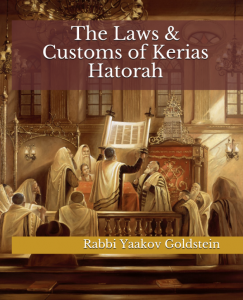
Looking at the Torah scroll-The duty of the congregation during Hagbah:[1]
Looking at the Sefer Torah-Coming close to the Bima to see the words in the Sefer Torah:[2] During Hagbah, it is a Mitzvah upon every man and woman to see the writing of the Sefer Torah. [For this reason, every individual is to endeavor to come close to the Bima in order so he can read the words written in the Sefer Torah, which is shown during Hagbah.[3] Being close enough to read the words from the Sefer Torah at this time draws down a great revelation of light on the individual.[4] It is proper to search for a word which begins with the same letter as one’s name, and to look at it.[5] However, women who are within their period of menstruation are not to look at the Sefer Torah.[6]]
Bowing to the Sefer Torah:[7] When the people see the writing of the Sefer Torah by Hagbah they are to bow towards it. [Practically, however, this is no longer widely accustomed today.[8]]
Pointing at the Sefer Torah: Some are accustomed to point at the open Sefer Torah during Hagbah.[9] Others are accustomed to point their Tzitzis at the Sefer Torah and then kiss it.[10] Practically, it is not the Chabad custom to point one’s finger or Tzitzis at the Sefer Torah.[11]
Saying Vezos Hatorah:[12] When the people see the writing of the Sefer Torah by Hagbah they are to say the verse [Devarim 4:44] of Vezos Hatorah [and the other verses printed in the Siddur[13]]. [Some Poskim[14] rule that one may not recite this verse unless he actually sees the words in the Sefer Torah, and is not to begin saying it until he does. Nevertheless, it is not required for him to be close enough to the words to be able to read them, and so long as they are within his view it is valid.]
Standing: Every individual is to stand while the Torah is lifted for Hagbah.[15] This applies even if the Sefer Torah is on an elevated platform called a Bima.[16]
|
Q&A May one in the midst of Davening recite Vezos Hatorah?[17]One may not recite Vezos Hatorah in the midst of Davening, past Baruch Sheamar. When two Sifrei Torah are removed must the person holding one of the Sifrei Torah stand when Hagbah is done to other Sefer Torah?[18] No. |
[1] See Piskeiy Teshuvos 134:6-8
[2] Michaber 134:4; Miseches Sofrim 14:14; Ramban on Torah Ki Savo 27:27; Shibulei Haleket 77; Mordechai Halachos Ketanos 14; Tashbeitz 188; Ketzos Hashulchan 25:13
[3] Siddur Admur; M”A 134:3; Shaar Hakavanos Kerias Hatorah; Shulchan Hatahor 147:6
Other opinions: Some Poskim rule that if one is a great distance from the Sefer Torah then he should not come towards it for the sake of seeing its letters, as it appears like haughtiness. [Shaareiy Efraim 10:13]
[4] M”A 134:3; Shaar Hakavanos Inyan Kerias Hatorah; M”B 134:11 in name of Mekubalim
[5] Ben Ish Chaiy Toldos 2:16; Kaf Hachaim 134:13
[6] Admur 88:2; M”A 88:2; Taz 88:2; Rashal; Binyamin Zev 153
[7] Michaber 134:4; Miseches Sofrim 14:14; See Piskeiy Teshuvos 134:7
Other opinions: Some Poskim negate bowing to the Sefer Torah by Hagbah, as we find no source for such a matter. [Shiltei Hagiborim Kiddushin 1 p. 14b]
[8] Kneses Hagedola Y.D. 282; Siddur Yaavetz; Har Tzevi 1:64; Divrei Yatziv 1:76; See Piskeiy Teshuvos ibid
[9] Meam Loez Parshas Ki Savo 26:27; Sefer Hachaim 3:6; See Piskeiy Teshuvos 134:7
[10] Sefer Hachaim ibid; Meam Loez ibid
[11] Sefer Haminhagim p. 32 [English]
[12] Michaber 134:4; Miseches Sofrim 14:14; See Piskeiy Teshuvos 134:8
[13] See Siddur Admur for the list of verses that we recite; See Michaber ibid that one says the verse of Toras Hashem Temima
Saying Al Pi Hashem Beyad Moshe: Many are accustomed to reciting the half verse of Al Pi Hashem Beyad Moshe. [See Siddur Shelah; Siddur Yaavetz; Likkutei Maharich; Aruch Hashulchan 134:3; Darkei Chaim Veshalom 224; Piskeiy Teshuvos 134:8]
[14] Shaareiy Efraim 10:13; M”B 134:12; Betzel Hachochma 5:54; Piskeiy Teshuvos ibid
[15] Elya Raba 149; Shaar Hatziyon 146:18; Kaf Hachaim 146:24
[16] Elya Raba ibid; Shaar Hatziyon ibid; Kaf Hachaim ibid; See Taz Y.D.D 282:1; Piskeiy Teshuvos 134:7
Other opinions: Some Poskim rule one is not required to stand in such a case, unless he is sitting on the Bima platform. [M”A 146:6; See Rama Y.D. 242:18; Beis Yosef Y.D. 282 Rashba 3:281] The final ruling and custom is like the stringent opinion.
[17] Chaim Sheol 68; Kisei Rachamim 14:14; Kesher Gudal 11:21; Maharshag 3:52; Kaf Hachaim 134:20; Igros Kodesh 3:149, printed in Shulchan Menachem 1:214; Yabia Omer 5:8; Piskeiy Teshuvos 134:14
[18] Kinyan Torah 5:16



Leave A Comment?
You must be logged in to post a comment.